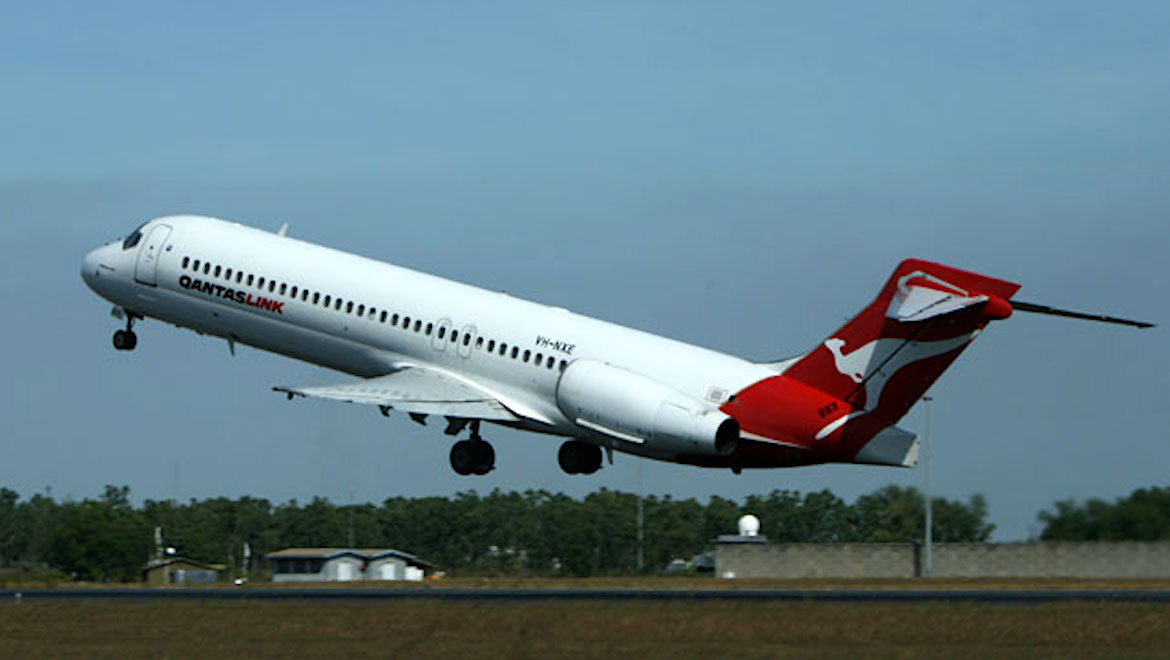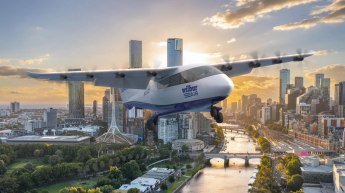
Qantas will send its Boeing 717s offshore for their heavy maintenance checks after concluding keeping the work in Canberra was not sustainable.
The airline confirmed in a statement to Australian Aviation on Wednesday Singapore-based ST Aerospace had won the contract to do the heavy maintenance work on the 717s following a competitive tender process. The contract begins in July 2019.
“We’ll continue to do the majority of maintenance on our B717 aircraft in Canberra,” a Qantas spokesperson said in an emailed statement.
Qantas said about 25 QantasLink engineers at the Canberra hangar would continue this work.
Australian Licensed Aircraft Engineers Association (ALAEA) federal secretary Steve Purvinas said the move would leave 40 aircraft engineers out of work.
“Because the workers are contractors, there has been no consultation, there will be no redundancy payouts and the engineers will be left high and dry,” Purvinas said in a statement.
Qantas established the heavy maintenance facility in 2015, when it took the work off Cobham Aviation Services and brought it to Canberra.
At the time, ACT chief minister Andrew Barr said the agreement between the government and QantasLink to bring its 717 fleet to Canberra for heavy maintenance was for five years and allowed for further expansion.
The Qantas statement to Australian Aviation on Wednesday said the heavy maintenance work had been contracted out to a third-party provider Korr Aviation under a four-year contract that was due to expire in April 2019.
It said Korr Aviation would seek redeployment for its affected contractors, adding that opportunities within the Qantas group would also be explored.
In explaining the decision to take the work offshore, the statement said the maintenance requirements for the fleet of 20 717s over the next few years would include periods of up to a month where there would be no work for Korr Aviation’s contractors.
This was not sustainable, Qantas said.

Further, ST Aerospace’s facilities would help reduce repair times of components.
ST Aerospace is part of the Singapore Technologies Engineering group of companies and conducts maintenance, repair and overhaul (MRO) work at its facilities both in Singapore and around the Americas, Asia Pacific and Europe. The company says it is the largest commercial airframe MRO service provider.
Qantas said ST Aerospace was approved by Australia’s Civil Aviation Safety Authority (CASA) and already did work for Qantas, Jetstar and Qantas Freight.
And all maintenance would be done with oversight from Qantas Engineering and Cobham staff.
Heavy maintenance involves stripping the aircraft and life-limited components, including engines, for detailed inspections and servicing.
Meanwhile, line maintenance covers tasks such as regular daily checks, minor servicing and repairing/replacing broken parts.
Cobham has flown the fleet of 20 717s for QantasLink since 2005, supplying pilots and cabin crew for the fleet. The company also conducts some line maintenance on the aircraft.
In 2016, the contract was extended for a further 10 years. Cobham told the London Stock Exchange the 10-year contract was worth A$1.2 billion.
In addition to serving regional routes mainly in Western Australia, Queensland, the Northern Territory and to Canberra, Qantas has in recent years utilised the 717 fleet on other capital city services, such as Hobart to Melbourne and Sydney, and Adelaide to Sydney.
The Qantas-Cobham relationship stretches back 25 years, given Cobham previously flew BAe-146 aircraft for QantasLink.


The end of heavy maintenance work in Canberra follows the progressive shuttering of Qantas’s engineering facilities at Sydney, Melbourne Tullamarine and Avalon, resulting in hundreds of job losses.
Qantas’s Brisbane hangar does heavy maintenance work on the 75 Boeing 737-800s and 28 Airbus A330-200/300 fleet.
The QantasLink hangar at Canberra Airport was originally built with ACT government support for Impulse Airlines to maintain the short-lived low-cost carrier’s Boeing 717s there.
Qantas acquired Impulse Airlines in 2001, inheriting the hangar before it was completed, as well as Impulse’s fleet of 717s. The hangar is designed to accomodate three 717s (or two 737s or a single 767).
















Lechuga
says:Imo it’s time Qantas started looking at the A220 or Embraer E2 families to replace these, as much as I love them they’re getting ancient.
Chris
says:The A220 would be a better option, as it is in essence the replacement for B717 and BAE146 being in the 3+2 seating market. The A220 has more flexibility from the short take off/landing of the A220-100 to the medium haul over water capability of the A220-300, would make a good replacement for Qantas 2nd tier jet network and short haul international routes, more so than what the Embraer E2’s can do.
Stuart
says:The A220 now has 180 minute ETOPS (not sure of the new acronym) approval.
David
says:“keeping the work in Canberra was not sustainable”
sounds like code for way too expensive.
Note: Alliance apparently now sends all their Fokkers to Bratislava (Europe) for heavy maintenance.
Gary
says:David,
They have been doing that for a number of years since purchasing the Austrian Airlines F100 fleet.
Corey
says:Qantas really should be looking at ordering a decent sized fleet of A220s. Not only to replace the current B717s but also expand a little. It would be nice if Qlink flew out of regional hubs such as Sunshine Coast to Cairns, Townsville, Mackay, Rockhampton and Gladstone and then South to New Castle, Canberra etc. I’m not talking about daily flights but a couple of flights per week. From what I’ve been able to read the A220 is cheaper overall to buy, own and operate than the E2s. Plus I’m sure Qantas could do a deal with the QLD Government and Sunshine Coast council to build a hanger and do maintenance for say 10 years with 2 5 years extensions which would see the life of the aircraft. Furthermore, why isn’t Qantas expanding Qantas Freight? They’re buying the 787s so they could replace a couple of A330s in which could be converted into freighters along with some additional 747-400ERFs and 747-8Fs. The Air Freight market is growing so I’m surprised they’re not trying to capitalise on it.
Red Cee
says:I agree with Lechuga, Qantas need to be looking at the A220.
Mac Carter
says:So more skilled work exported overseas.
Seems Australia is somewhat expert at exporting skilled jobs and revenue to overseas business.
With respect the potential B 717 replacement, both the A220 and E Jet have low wing mounted engines.
whereas the B 717 / F 100 / F 70 have high tail mounted engines, more clearance from runway debris,
which operators must consider when operation from isolated runways.
Lechuga
says:I totally agree with that. However the 717s and Fokkers also do a lot of regional work on solid runways too, and there’s a bigger more that aren’t really looked at right now either. I personally believe something like the A220 should be purchased by Qantas for routes to places such as Canberra, Newcastle, Tasmania, Regional Queensland and places like Darwin/Alice Springs. I think it would be a great addition.
Mac Carter
says:The A 220 and E Jets are great aircraft, perfect for regional services.
However for remote area runways, locations like Century / Cannington / Osborne and many other remote minesite runways spring to mind, high tail mounted engines are a better option. Ingested air will be cleaner, cooler and, hopefully, free from harmful objects.
I draw attention the comment by Leo Schofield, (Qants acquires stake in Alliance ) with respect to the tail mounted engines installed on their Fokkers
Craigy
says:A decision on what to replace the majority B712 and F100s with could be tied up with a decision to replace the domestic mainline fleet. An order of B737 Max/E2Jets or A32X/A22X would probably achieve the best pricing from the manufacturers
Jeff
says:While in the shed how about a bit of retro? Blue tail with a white T. C’mon Q it would be great.
MERVYN CROWE
says:B717 maintenance to XSP…there will soon be no aircraft maintenance undertaken in Australia, a shame, but very unfortunately, financial reality. Seems at least some 717 work will still be carried out in CBR.
COBHAM do minor and overnight maintenance on the 717s based in Perth thankfully.
Aircraft engineering apprentices must be thinking now, why bother, theres no future for them in Australia.
Yes the CS300/E220 would seem to be a contender, watched them in action at LHR recently.
E2/E190 also a great little aeroplane, well worth evaluating, pity VA disposed of theirs.
Mac Carter
says:Agree with Mervyn with respect to Aircraft engineering apprentices having no future in Australia.
I always enjoyed travelling in the E 190’s operated by virgin, perfect for the Townsville routes.
Had reason to use the Airnorth Townsville – Toowoomba service recently, Their E 170 was full
both ways. Great service
Tristan
says:It is certainly sad to see another type of aircraft going offshore and further job losses to a shrinking sector of aviation. But I can tell you that many in the industry believe QANTAS had this planned all along. The original 717 heavy maintenance was done by Cobham in Adelaide. As a former employee (of both airlines) I know they did a very good job which resulted in what was for a time the highest dispatch reliability of any fleet Australia wide. However, politics got involved and QANTAS began to move the goal posts. Setting tighter demands on Cobham which would make it difficult to avoid late penalties, resulted in break even profit and what would seem like poor performance on paper. Once they had enough ammunition they were able to justify awarding it back to themselves in Canberra and using Korr staff along with taking away the Canberra line base that Cobham had done all the legwork setting up. They then shed a large percentage of the heavy maintenance work back to the line for Cobham engineers to do on overnight turnarounds at other ports around Aus. Korr offered well below average wages which meant trouble sourcing experienced and reliable staff compounded by difficulty getting people to work in CBR. The end result was “C-checks” being done for $600-900k in 28 days by Cobham we’re now being done by Korr for $1.5m in 45 days with a reduced amount of actual work being done. Dispatch reliability dropped so low that cancellations were common and a “centre for excellence” staffed by Cobham and QantasLink line engineers had to be set up to address the problem of aircraft coming straight out of Canberra. Now QANTAS have enough of a performance track record on Canberra to justify moving the work offshore. However, they are looking to still have staff employed in a “centre of excellence” role to check over each aircraft upon its return from Singapore. Why would you need this? Do they expect the returned product to be of similar quality to Canberra? Under Cobham there was no need for such an area. Aircraft were flown direct to Perth or Brisbane and entered service immediately. If QANTAS really wanted to keep jobs and skills in Australia they would have awarded the contract back to Cobham to carry out the work either in Canberra or Adelaide. They wanted this work offshore all along and setup the pieces to make it seem a good move. The ST Aerospace costs will be a lot less than Korr and Canberra but probably close to what Cobham we’re charging. However, with the aircraft all the way over in Singapore, good luck getting urgent parts robberies or AOG spares. Companies like Cobham and Alliance specialise in maintaining old fleets and should be recognised as vital for keeping the best performance and safety in older and discontinued airframes whilst helping to maintain a skill set of trades that are fast dying out in Australia.
Bob N
says:I agree with Tristan 100%-I am retired LAME of over 40 years experience.